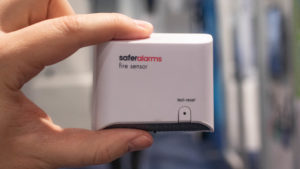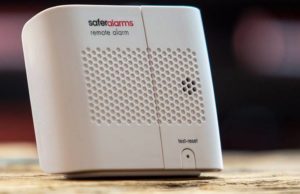
Smart Home Technology can be pretty cool. Unfortunately when we look at Smart Home Tech, we tend to forget the most important device.
History of Smoke Detectors
Smoke detectors were invented in 1890 by Francis Robbins Upton. In 1965 Duane Pearsall, the “father of smoke detectors” developed the “SmokeGard 700”. It was considered to be the first home smoke detector. Technology wise there has been a little upgrade to the approach of these traditional detectors. There are two types of technology:
- Ionization smoke detectors – A chamber contains two plates that generate an electric current. If smoke interrupts that current, an alarm sounds.
- Photoelectric smoke detectors – They incorporate a light beam that shines into a receptor inside the devices. If smoke interrupts the beam in any way, the alarm sounds.
Smoke Detectors Alone have challenges
Some fires begin with smoke before intense heat builds up. In such cases. smoke detectors can sound the alarm before heat detectors activate. However, there are some challenges with Smoke Detectors:
- In dusty or dirty environments false alarms can be triggered.
- Smoke detector installed in close proximity to a potential source of fire may melt before going off.
- By the time you hear an alarm it may be too late because of the time it takes smoke to travel to the detector.
This year, you should consider upgrading your home fire system and adding heat sensors. You may ask, why should I install heat detectors? Are smoke detectors not good enough? Both can detect a fire, but these products are designed to serve different needs. However, the difference between the two is dramatic. In cases where there are high flames, intense heat and little initial smoke, smoke detectors may not be the right approach. Heat detectors are intended to minimize property damage by reacting to the change in temperature caused by a fire.

Heat Sensors & Smoke Detectors are a Safer Approach
New York based Safer Alarms™ have created a mobile, wireless High-Tech heat sensor system to help address the limitations of Smoke detection units. The Safer Home Alarm System uses an intelligent approach to home fire safety architecture. The Safer Home Sensor detects when the temperature hits the “danger zone” (150 degrees F or higher) and will transmit the alerting signal to the alarm receiver. In case of a fire, the sensors will be scarified while the remote will continue to alarm.

The Safer Alarms Heat Sensors are small enough to fit in the palm of your hand
Installation of the Safer Home Alarm sensors and remote are easy. Simply place the heat sensor above any outlet in the highest risk locations in your home (ie kitchens, laundry rooms, baby nursery etc). Install the remote alarm in a location where you know it will be heard (ie bedroom, doorways etc). The communication between the sensor and remote alarm is established wirelessly.
The Safer Home Alarm sensors and remote are powered by AA batteries. Battery life is multi-year. However you will know when it is time to replace the batteries. The Safer Heat Sensor units will start to blink with a red LED when batteries are low. The Safer Remote unit will also (chirp) to let you know that the batteries need to be replaced.
By going where smoke detectors cannot, heat sensors like the Safer Alarm Sensors will transform your home fire safety system.

The Safer Alarms Remote connects wirelessly to the sensors
Features and Specifications
- Dimensions: 453 x 318 x 188mm
- Weight: 45.6 kg
- Colors: White
- Connectivity: Wireless
- Battery:
- Type: Regular AA alkaline battery (not included)
- Life: Multi-year battery life
For more information or to acquire the: Safer Home Alarm System
About Safer Alarms™
Revolutionizing the way people and property are protected from fire
